It’s Day 23 of The Kasturi/Files at Speculative Chic! Gemma Files and Sandra Kasturi talk about horror movies every day in this Halloween month. Today we continue across the world to Singapore and the Philippines for some ghostly doings in a girls’ school. (Some spoilers!)
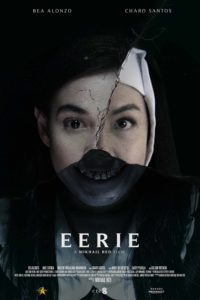 Sandra: Seriously, is there anything creepier than nuns? The way they seem to glide across the floor — their habits are long enough that you never see their feet, so who knows if they’re touching the ground? Actually, the only thing creepier than nuns is maybe nuns in a Catholic girls’ school, where the girls are all in uniform and therefore look almost exactly the same . . . cloned supernatural teens or something worse. Hey, that’s just what I bring to this in my own head before the movie even starts! The movie in question being the Singaporean/Filipino co-production called Eerie.
Sandra: Seriously, is there anything creepier than nuns? The way they seem to glide across the floor — their habits are long enough that you never see their feet, so who knows if they’re touching the ground? Actually, the only thing creepier than nuns is maybe nuns in a Catholic girls’ school, where the girls are all in uniform and therefore look almost exactly the same . . . cloned supernatural teens or something worse. Hey, that’s just what I bring to this in my own head before the movie even starts! The movie in question being the Singaporean/Filipino co-production called Eerie.
Gemma: Mikhail Red’s Eerie (currently available on Netflix) is a horror film which gleefully combines several of my favorite scary things in one narrative: an all-girls private boarding school full of alternately sad and creepy kids, an apparent “suicide plague,” hardcore Catholic nuns who all too often want to save their charges’ souls at the expense of their bodies, guilt, grief, and the general difficulty of being a psychic guidance counselor when A) nobody wants to listen to you and B) at least some of the kids you’re trying to counsel are already dead. Is it perfect? Probably not. Is it an alternately fun and frightening time? Absolutely.
Sandra: Yeah, there are some things in Eerie which seem a bit hackneyed and overly trope-y, but it’s still a nice little chiller and a good way to while away a couple of hours. Plus, I always like to see scary shit that comes from cultures not my own, because it’s fascinating to look at what’s universal and what’s not. Like that hair-in-the-face female ghost thing that is so Japanese, but still scared the ever-living crap out of North American audiences when all that J-horror made it across the pond. So now those ghosts have become part of our lexicon of fright, evolving our perceptions of how we talk about things that go bump in the night, much like languages evolve and change when they rub up against each other.
Gemma: We begin with the Santa Lucia Academy for Girls’ designated area to avoid: the Haunted Bathroom Stall. This is the last stall but one in the Academy’s only bathroom, a.k.a. the only real place for terrified little women-to-be to pee in the middle of the night, if they don’t want to get punished for wetting the bed. A girl in need — Anna — begs her nearest fellow student to come to the bathroom with her, but the other kid’s far too sleepy to play buddy system tonight, so we follow her down the hall and into the toilet of doom, where she makes sure to stay as far away from the Haunted Stall as possible. Sadly, this doesn’t really end up helping, as she first freaks herself out by remembering the story of what happened to make said stall so haunted (a girl named Erika hung herself in there), then emerges to a jump-scare double-punch of her own reflection turning around in the mirror to reveal someone else’s face, after which she gets grabbed from the front by a pair of decayed phantom hands! The next morning, we discover the other girls all gossiping about how Anna’s awful experience made her quit school and go home, which is . . . really, completely understandable. Anna’s the most practical person we’re going to meet during this whole film: you’d probably be Anna too, if that happened to you. I know I would.
Sandra: Can I just say that the Santa Lucia Academy has the creepiest fucking statue ever as their representation of their patron saint? Ugh! It kind of looks like Justice — a woman with a blindfold, but! but! wait for it: she’s holding a plate, and her eyes are on the plate looking at you! On the plate! WTF?? Double ugh! Like an escapee from a more demented version of Pan’s Labyrinth. If I had to go to school here, I would be just as much of a basket case as all these teens. Just saying.
Gemma: Next, we’re introduced to our protagonist, aforementioned guidance counselor Miss Pat (Filipino star Bea Alonzo), who’s trying to assure the girl who wouldn’t go to the John of Evil with Anna — Joyce — that none of this is her fault. But Joyce just wants to talk about what happened to Erika, as do all the other girls Miss Pat sees that day; they’re sure that Erika continues to roam the halls of Santa Lucia, very definitely not confining herself to the bathroom. The Academy’s principal Sor Alice (Charo Santos-Concio) refuses to listen to Miss Pat when she reports this at the end of the day. “Girls tell stories,” she says. “It’s a distraction. They need to pray and study, and if that doesn’t work…” Punishment seems to be the implication — the same kind of punishment that Erika regularly incurred for various violations, and which may eventually have led to her suicide. Luckily, however, Miss Pat has another way to deal with the matter: go back to her office, sit quietly in the dark, and open her mind, waiting for an appointment with Erika herself.
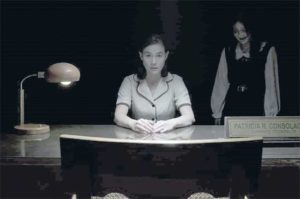
Sandra: That was one of the creepiest moments in the film for me. While Miss Pat is sitting there, lining up her pens and pencils in true OCD fashion, one rolls onto the ground and as she crawls under her desk to pick it up, all of a sudden she sees a student’s feet in the chair across from the desk. Feet with one shoe missing. It’s subtly done, and it gave me such a chill. It’s Erika, of course. Eeeeee!
Gemma: As played by Gillian Vicencio, Erika most often looks like a little girl with raggedly trimmed hair, alternately sympathetic and terrifying. She’s perfectly fine with letting Miss Pat feel sorry for her, or driving a wedge between her and Sor Alice by implying that Sor Alice might have faked her suicide. She claims to care deeply for at least one of the other girls, her former girl-crush Clara, but has no problem with suddenly popping out of nowhere and scaring the crap out of her, appearing to her in forms so hideous they literally make Clara’s eyes bleed. And then there’s her habit of possessing living people and making them kill each other, either for the sheer pleasure of it or in order to assuage her potentially eternal loneliness by . . . “making friends.” Literally. Like Samara in Gore Verbinski’s The Ring, Erika remains just human enough to make living people feel ambivalent about trying to get rid of her — her life was pretty much a parade of misunderstandings, parental abuse, bullying, pariah-dom and Sor Alice attempting to pray/beat what she thought might be “the gay” out of her, culminating in a moment of anger, hatred, and weakness that she’ll never get back. But what she is now is something that can’t just be allowed to continue on its merry way, especially not once she decides Miss Pat is the only person who really understands her enough to share this purgatory she’s condemned herself to.
Sandra: See? Evil nuns. Though that trope is turned on its head a bit when we have a confrontation between Miss Pat and Sor Alice, and you finally get Sor Alice’s side of the story, how she simply didn’t know how to deal with Erika, and how all she could sense in the girl was hatred and rage. Now, we of course assumed that this girl felt those things because of how she was tormented, but Sor Alice’s version suggests that maybe there’s more to it than that — maybe Erika was bad from the get-go, which means everyone ganging up on her can be read as a kind of herd-mentality attempt at getting rid of the predator amongst them. Now, I’m not saying this is the correct way to look at this. I’m just playing Devil’s Advocate. Or, rather, Nun’s Advocate.
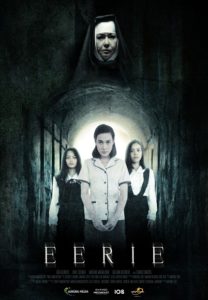 Gemma: At its best, Eerie reminds me strongly of Guillermo del Toro’s The Devil’s Backbone, except with fewer dudes and more jump-scares. The cultural background it inhabits has intriguing things to say about colonialism’s after-effects, especially in terms of the way that the Catholic Church — a sociopolitical structure imposed on the Philippines from the outside, meant to erase or supplant their original system of indigenous beliefs — provides a system within which people like Sor Alice can succeed, but only by essentially killing the softer parts of themselves. Santos-Concio definitely works hard to get across that Sor Alice isn’t a complete monster; she genuinely thinks she’s doing “what’s best” for girls like Clara and Erika, offering them chances they won’t get otherwise for academic excellence and a future in which they’ll be able to escape the economic trap their parents are stuck in. But she also knows she played a primary hand in making Erika what she is now, a self-damned parasite feeding off the terror of her former classmates, and it’s killing her by slow degrees. Whereas Miss Pat, the Miss Honey to Sor Alice’s Trunchbull (stealth Matilda reference), often comes off as a bit too nice and reasonable to understand exactly how much danger Erika presents in her current form, not just to everyone else, but also to her. Mikhail Red wisely uses our fear for her as a way to ramp up the fear quotient in general, which only adds to Eerie’s overall enjoyment factor.
Gemma: At its best, Eerie reminds me strongly of Guillermo del Toro’s The Devil’s Backbone, except with fewer dudes and more jump-scares. The cultural background it inhabits has intriguing things to say about colonialism’s after-effects, especially in terms of the way that the Catholic Church — a sociopolitical structure imposed on the Philippines from the outside, meant to erase or supplant their original system of indigenous beliefs — provides a system within which people like Sor Alice can succeed, but only by essentially killing the softer parts of themselves. Santos-Concio definitely works hard to get across that Sor Alice isn’t a complete monster; she genuinely thinks she’s doing “what’s best” for girls like Clara and Erika, offering them chances they won’t get otherwise for academic excellence and a future in which they’ll be able to escape the economic trap their parents are stuck in. But she also knows she played a primary hand in making Erika what she is now, a self-damned parasite feeding off the terror of her former classmates, and it’s killing her by slow degrees. Whereas Miss Pat, the Miss Honey to Sor Alice’s Trunchbull (stealth Matilda reference), often comes off as a bit too nice and reasonable to understand exactly how much danger Erika presents in her current form, not just to everyone else, but also to her. Mikhail Red wisely uses our fear for her as a way to ramp up the fear quotient in general, which only adds to Eerie’s overall enjoyment factor.
Sandra: I’m such a sucker for a stealth Matilda reference any time! I’m also a sucker for Catholic imagery and mythology, who knows why, since I grew up with no religion at all. Or maybe that’s exactly why I find it so fascinating! And who but the Catholics have the infrastructure for demonic possession, dealing with the supernatural, that violent legacy of colonialism, as you say, not to mention of course the dark history of abuse. I can’t help but find it fascinating in a way I can’t quite put my finger on. Maybe I just have a ritual fetish?
Gemma: Hey, no kink-shaming. I’ll mention two other quick things: I’m also obsessed with Catholic saints and martyrs, and as you’ve mentioned, Eerie contains at least one absolutely gorgeously dreadful example of such — Santa Lucia/Saint Lucy, after all, is usually depicted carrying her own torn-out eyes on a plate, which is how she became known as the patron saint of (amongst other things) stained-glass workers and optometrists. There’s also a scene in which Miss Pat is interviewing two kids at once but neither of them will stop scribbling away at what turn out to be the drawings of two separate half-faces which, when placed together, form a whole face of extreme grossness. We then jump-cut to Erika appearing right between the two girls, her equally horrifying face sporting a wide, bloody-toothed grin. That’s some extra-fine creep, if I dare say so myself.
Sandra: Santa Lucia is normally portrayed like that? Good lord. Organized religion is weird. And so is Eerie — but very much recommended nevertheless.
Cocktail: Creepy Cocktail
Sandra: I am including this one for two reasons: A) it sounds delicious, and B) it’s from Martha Stewart! Seriously! Martha Stewart! I don’t know why I find that so funny, but I do.
 Ingredients:
Ingredients:
- Black sanding sugar (I don’t know what this is. Just buy colored sugar, or use food dye on regular sugar.)
- 1 lime wedge
- Ice
- 1 tablespoon fresh lime juice
- 1 ounce light rum
- 3 tablespoons simple syrup
- 1/4 cup 100-percent pomegranate juice
- 1 ounce dark rum
- Licorice spider, for garnish (optional; see note below)
Directions:
Spread black sanding sugar on a saucer. Rub a lime wedge around the rim of a glass, then dip in sugar to coat. Add ice.
Fill a cocktail shaker with ice, add all remaining ingredients, except dark rum, and shake. Strain into glass, leaving space at top. Gently pour in dark rum so it floats on top. Garnish with licorice spider tied to a stirrer.
Note on garnish: To create the licorice spider, loop a 36-inch-long black licorice lace around three fingers four times. Remove fingers and wrap long end of lace around middle of bundle three times. Tuck loose end under last wrap and pull through to secure. Cut through the ends of the bundle to create dangling legs on each side. (Okay, normally I wouldn’t futz with something like this, but it actually sounds pretty simple.)
Book Recommendations
Sandra: For eerie girls’ boarding schools, it’s hard to beat Lois Duncan’s Down a Dark Hall, in which psychic girls are groomed to channel dead artists and complete the work they were unable to before they died — Duncan wrote it from the POV that she’d never seen a gothic aimed at a young adult audience before, and started a whole trend. (I just have to say that I love Google. I was wracking my brain trying to figure out what that book was. So I Googled “young adult book 1970s gifted girl creepy boarding school” and the first thing, the very first thing!, that came up was Down a Dark Hall, which was of course the book I was looking for. Amazing! If you recognize the name, Duncan is perhaps best known for I Know What You Did Last Summer, which is a good book, and a slightly silly but still entertaining movie.) Also: I love books and movies set in boarding schools. Which is probably why I practically swooned over Harry Potter.
In a slightly more comedic vein, but still involving high school teens talking to dead people, you can try ChiZine’s Dead Girls Don’t by Mags Storey, which is kind of Nancy Drew meets The Sixth Sense.
Finally, in William Sleator’s House of Stairs, a control group of orphans is subjected to a weird, Skinner Box-ish experiment aimed at figuring out just how much pressure has to be applied via a scarcity economy before otherwise “normal” kids will hurt or even kill each other for a little bit of food or water. If you don’t know Sleator’s work, please read everything he’s written!
All ostensibly marketed as children’s books, and yet . . .
Gemma: In terms of creepy little girls, S.P. Miskowski’s In The Light is extremely good, extremely eerie, and not a bad way to break into her Skilute cycle of novellas (Knock Knock, Delphine Dodd, The Worst Is Yet To Come) — they all pivot on forgotten history rearing up to bite asses from beyond the grave, which sounds fairly Erika-esque to me. And then there’s Ronald Malfi’s well-named Little Girls, in which a woman moves back to the house she lived in as a child, only to get dive-bombed by memories about her best friend who disappeared back then, and looked remarkably like the girl she now sees hanging around with her own daughter.
Then there’s the toxic friendship which develops between two young girls in Patricia Clapp’s Jane-Emily, one of whom just happens to be a “hateful, willful, selfish child” who plans to bring herself back from the dead by occupying her new pal’s living body. Good times!
 Sandra Kasturi is the publisher of ChiZine Publications, winner of the World Fantasy, British Fantasy, and HWA Specialty Press Awards. She is the co-founder of the Toronto SpecFic Colloquium and the Executive Director of the Chiaroscuro Reading Series, and a frequent guest speaker, workshop leader, and panelist at genre conventions. Sandra is also an award-winning poet and writer, with work appearing in various venues, including Amazing Stories, Black Feathers: Dark Avian Tales, Prairie Fire, several Tesseracts anthologies, Evolve, Chilling Tales, ARC Magazine, Taddle Creek, Abyss & Apex, Stamps, Vamps & Tramps, and 80! Memories & Reflections on Ursula K. Le Guin. She recently won the Sunburst Award for her short story, “The Beautiful Gears of Dying,” in the anthology The Sum of Us. Her two poetry collections are: The Animal Bridegroom (with an introduction by Neil Gaiman) and Come Late to the Love of Birds. Sandra is currently working on another poetry collection, Snake Handling for Beginners, a story collection, Mrs. Kong & Other Monsters, and a novel, Wrongness: A False Memoir. She is fond of red lipstick, gin & tonics, and Idris Elba.
Sandra Kasturi is the publisher of ChiZine Publications, winner of the World Fantasy, British Fantasy, and HWA Specialty Press Awards. She is the co-founder of the Toronto SpecFic Colloquium and the Executive Director of the Chiaroscuro Reading Series, and a frequent guest speaker, workshop leader, and panelist at genre conventions. Sandra is also an award-winning poet and writer, with work appearing in various venues, including Amazing Stories, Black Feathers: Dark Avian Tales, Prairie Fire, several Tesseracts anthologies, Evolve, Chilling Tales, ARC Magazine, Taddle Creek, Abyss & Apex, Stamps, Vamps & Tramps, and 80! Memories & Reflections on Ursula K. Le Guin. She recently won the Sunburst Award for her short story, “The Beautiful Gears of Dying,” in the anthology The Sum of Us. Her two poetry collections are: The Animal Bridegroom (with an introduction by Neil Gaiman) and Come Late to the Love of Birds. Sandra is currently working on another poetry collection, Snake Handling for Beginners, a story collection, Mrs. Kong & Other Monsters, and a novel, Wrongness: A False Memoir. She is fond of red lipstick, gin & tonics, and Idris Elba.
 Formerly a film critic, journalist, screenwriter and teacher, Gemma Files has been an award-winning horror author since 1999. She has published two collections of short work, two chap-books of speculative poetry, a Weird Western trilogy, a story-cycle and a stand-alone novel (Experimental Film, which won the 2016 Shirley Jackson Award for Best Novel and the 2016 Sunburst award for Best Adult Novel). Most are available from ChiZine Publications. She has two new story collections from Trepidatio (Spectral Evidence and Drawn Up From Deep Places), one upcoming from Cemetery Dance (Dark Is Better), and a new poetry collection from Aqueduct Press (Invocabulary).
Formerly a film critic, journalist, screenwriter and teacher, Gemma Files has been an award-winning horror author since 1999. She has published two collections of short work, two chap-books of speculative poetry, a Weird Western trilogy, a story-cycle and a stand-alone novel (Experimental Film, which won the 2016 Shirley Jackson Award for Best Novel and the 2016 Sunburst award for Best Adult Novel). Most are available from ChiZine Publications. She has two new story collections from Trepidatio (Spectral Evidence and Drawn Up From Deep Places), one upcoming from Cemetery Dance (Dark Is Better), and a new poetry collection from Aqueduct Press (Invocabulary).

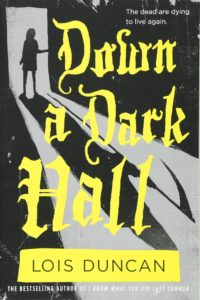
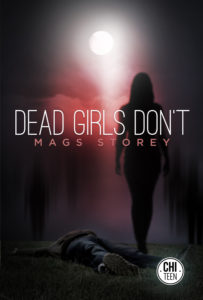
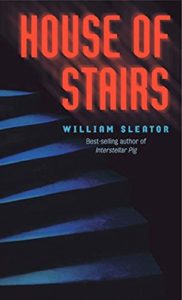
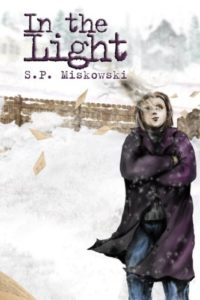
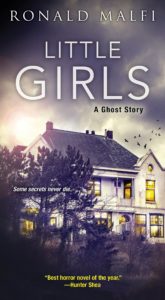
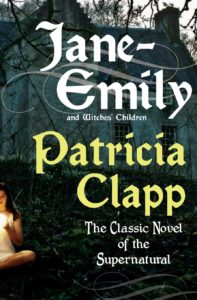
I had no idea this movie existed, and I’m super-excited to watch it!